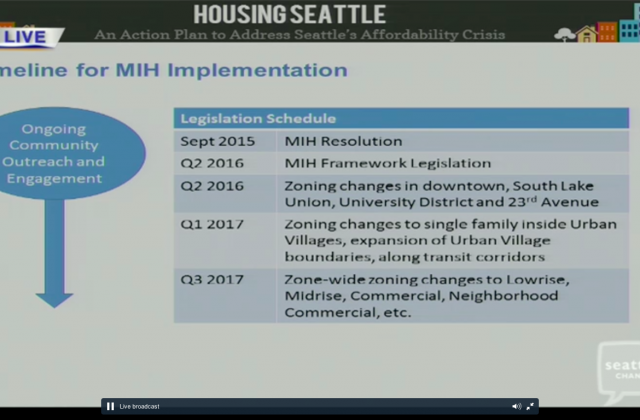The Latest on HALA: Too Early to be Worried?
I’m worried about where the Seattle City Council seems to be going with the recommendations of the Housing Affordability and Livability Agenda (HALA) Committee recommendations. Maybe it’s because just before yesterday’s HALA select committee meeting they voted down, 7 to 2, a sensible amendment to back off a legally dubious requirement for a project not subject to design review to go through it anyway because it is next to another recently built project. But what I heard at the HALA committee meeting wasn’t just procedural throat clearing; it sounded an awful lot like the City Council that has been making housing problems worse for the better part of the last decade, bathing themselves in process and half steps rather than bold moves to allow the building of more housing.
Here’s what concerned me. While Councilmember Tom Rasmussen won’t be around much longer, he still asked the typical and befuddled questions he’s known for. When upzones in exchange for mandatory inclusion of affordable housing came up, Rasmussen asked about growth targets. Amazingly he and some of his colleagues don’t seem to understand that the growth targets are not maximums but just a benchmark for new people moving into neighborhoods. This is after years and years and countless briefings on th subject. After reminding him of this, Rasmussen wanted to know about “infrastructure” for all the new people that would be aded to neighborhoods because of the upzones. No problem, Rich Feldstein from the Mayor’s office assured him, “we’re looking at impact fees.”
Councilmember Sally Bagshaw raised more questions from her “inner Tom Rasmussen” about infrastructure and transportation and process. What followed was a sustained discussion about community process. Of course upzones won’t just happen, everyone agreed, there will be lots and lots of process. Everyone will be asked what they think. Hmmmm. I thought we had a deal? A “Grand Bargain? Apparently, that deal is up for negotiation with 30 plus neighborhoods that will weigh in on the complex language agreed to by members of the HALA Committee.
Here’s how John V. Fox described the typical City process around upzones:
After establishing these immutable ground rules, the facilitator intones that together in this very room, we’ll all work toward “innovative solutions” to “ensure that the rich cultural fabric and heritage of the city will be maintained and enhanced.” You’re told, “The ideas we generate will only be limited by our potential to imagine them.”
Next, you’re broken up into “visioning” groups, usually by topic such as housing, transportation, public safety or open space, each led by a planner who writes down your ideas on butcher paper. Then everyone reconvenes and is asked to put green, yellow or red sticky notes next to the good, so-so or bad ideas for your neighborhood. A photographer documents all this.
You know. He’s right. Except that it’s usually the upzones that suffer from the process, not the other way around. Instead of big bold changes, this kind of process ends up producing a weak broth of indecision. Add to that the fact the Councilmember O’Brien has presided over non-stop attenuation of housing supply through over regulation during his tenure. There hasn’t been a single thing he had done in his time as Chair of the Planning, Land Use, and Sustainability (PLUS) Committee to add housing. It’s all been take aways, starting with small-lot and microhousing all the way to yesterday’s pointless effort to force design review on more housing projects, something that builders will avoid by building bigger, more expensive units.
This is the group, O’Brien, this Council, and staff, that will be leading the way to what the HALA has proposed as some of the most complicated legislation and financing the City has ever tried to produce and pass. Not even professionals have quite figured out exactly how or if the “Grand Bargain” will really work to produce more housing or more affordability. The City Councilmembers don’t even seem to understand how growth targets work. And yet the dog walking neighbor that demanded downzones to the low-rise zones a mile away from her own house will be able to weigh in on the details of the agreement.
I’m trying to be optimistic. Really. I’m trying.



